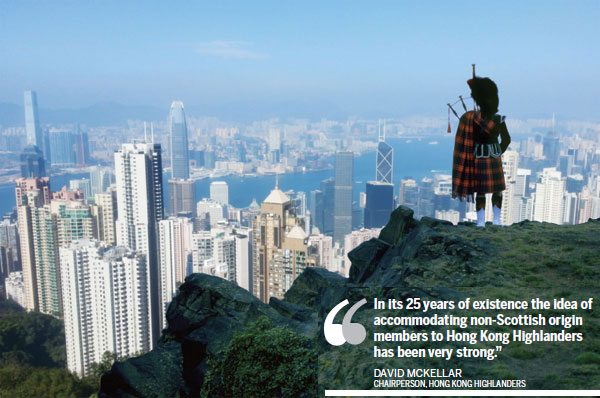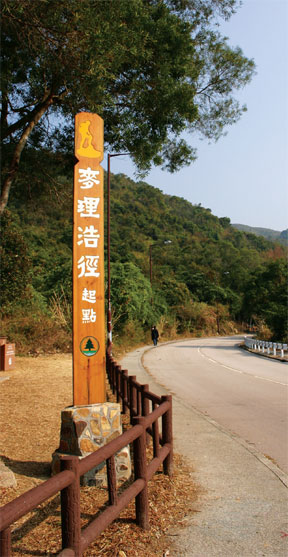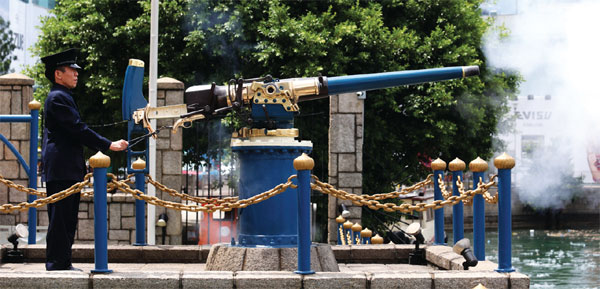Of bagpipes and ceilidh
Updated: 2014-09-17 06:18
By Chitralekha Basu(HK Edition)
|
|||||||||

Whether or not Scotland breaks away from the UK, following the independence referendum on Thursday, a few of HK's favorite things will forever remain Scottish. Chitralekha Basu has a quick round-up.
'I was enveloped in cold mists which lingered until I neared the summit. When they cleared to reveal patchy views of brown-green slopes studded with ghostly granite rocks, it was a Highland scene worthy of the trail's Scottish name," says Pete Spurrier, recalling his first time on a mountain trail in the New Territories that was as dreamy as it was intense. Named after Sir Murray MacLehose, the longest-serving governor of Hong Kong (1971-82), himself an avid hiker, the trail passes through terrain that takes in both beaches and mountain peaks - one of those sylvan pockets often obscured by the chrome and glass cityscape that is typically associated with Hong Kong.
"Whenever I hike and reach a vantage point where a Hong Kong vista of bays and islands can be enjoyed, one of those places where you can see the weather changing miles away in each direction, I am reminded of Scotland's west coast around Oban," says Spurrier, author of The Serious Hiker's Guide to Hong Kong.
Whether or not Scotland breaks away from the UK, following the referendum on Thursday, a few of Hong Kong's favorite things will forever remain a gift of the Scots. The resonances are evident in the naming of streets and spaces - Inverness Road, Dumbarton Road, Edinburgh Place. Aberdeen, an erstwhile fishing port with a cute array of boats in which fisher-folk still live and run their often ramshackle but lively restaurants, is named after George Hamilton-Gordon, fourth Earl of Aberdeen, former prime minister of the UK (1852-1855). Today Aberdeen is a hub for processing seafood and a wholesale fish market as indeed the original Aberdeen city and Aberdeenshire in Scotland remains today, apart from being a center of research in pisciculture.
The competitive edge Hong Kong holds today in global commerce probably began with the Scots. The HSBC Bank was founded by Scotsman Sir Thomas Sutherland in March 1865. The bank's hexagonal logo, designed by Austrian graphic artist Henry Steiner, is inspired by the cross of Saint Andrew, in deference to the founder's nationality. The firing of the Noonday Gun, a cannon mounted on a tiny jetty near the Causeway Bay Typhoon Shelter, is a daily ritual in remembrance of William Jardine and James Matheson, who were shipping tycoons from Edinburgh. Their firm, Jardine, Matheson and Co, begun in Canton in 1832, flourished when they set up shop in Hong Kong. They dabbled in pretty much everything - from railways to cotton mills, to distilling alcohol. They ended up owning businesses in Africa and Australia, putting Hong Kong on the world map of commerce and entrepreneurship.
|
Named after former Hong Kong governor of Scottish origin, Murray MacLehose, a hiking trail in New Territories takes in both beaches and mountain peaks. |
Indeed, Hong Kong would have been a different kind of place altogether, had it not been for the continuous and abiding presence of the Scots since 1842, says Shiona Airlie, the biographer of two eminent Scotsmen - Sir James Stewart Lockhart (1858-1937), a civil servant known for his empathy with the local Chinese and Sir Reginald Johnston (1874-1938), academic and diplomat who went on to be the in-house tutor of Puyi, the last emperor of Qing Dynasty (1644-1911).
Finding friends
"Scotland has always welcomed people from all parts of the world and in Edinburgh, because of the university, people were used to seeing other races in their midst, even in the 19th century" says Airlie. "This meant that when he arrived in Hong Kong, Lockhart - unlike many of his British compatriots - did not look upon the Chinese as inferior. He had close friends among the Chinese and Eurasian communities. He was godfather to several Chinese children. And he did what he could to maintain the Chinese character of the New Territories."
There is still much about Hong Kong that resonates with Scotland, it seems the Scots never went away. The hall of residence for male students at Hong Kong University is a Victorian castle, built between 1861 and 1867, by Sir Douglas Lapraik, a Scottish capitalist. Haggis, a generic Scottish preparation containing sheep's pluck (heart, liver and lungs) minced with onion and oatmeal, is available all the year round at Oliver's in Prince's Building in Central. Yuen's, on Des Vouex Road, tailors custom-made kilts. Several bands in town, such as The Hong Kong Pipe Band, meet regularly to practice Scottish music. Even musicians practicing specialized genres, such as ceilidh (Gaelic folk music), or music played on clarsach (Celtic harp), and of course bagpipes are not hard to find.
David McKellar, chairperson (or, Fear an Taigh, as they call it) of Hong Kong Highlanders, a society that holds weekly events featuring Scottish music and country dancing, points out most members are of non-Scottish origin. "Anybody interested in Scottish culture is welcome to join. In its 25 years of existence the idea of accommodating non-Scottish origin members to the society has been very strong."
The traffic between Hong Kong and Scotland is now close to 200 years old, says McKellar. It's a shared history that deserves celebration. "The sight of the kilt and the sound of the pipes and drums provide simple enjoyment to everyone, not to mention the mutual affection for golf and whisky!"
Contact the writer at basu@chinadailyhk.com
|
The daily Noonday Gun ritual near Causeway Bay is held in remembrance of William Jardine and James Matheson, two entrepreneurs from Edinburgh who put Hong Kong on the world map of commerce. Roy Liu / China Daily |
(HK Edition 09/17/2014 page7)

